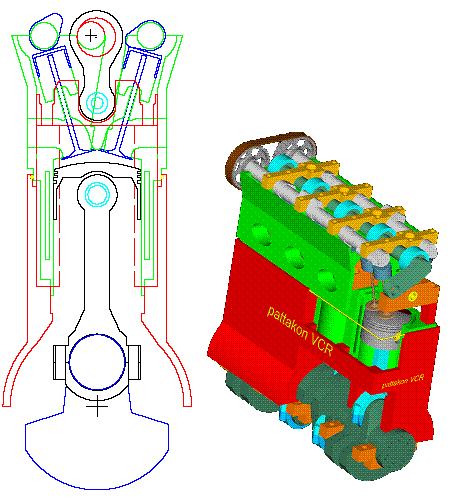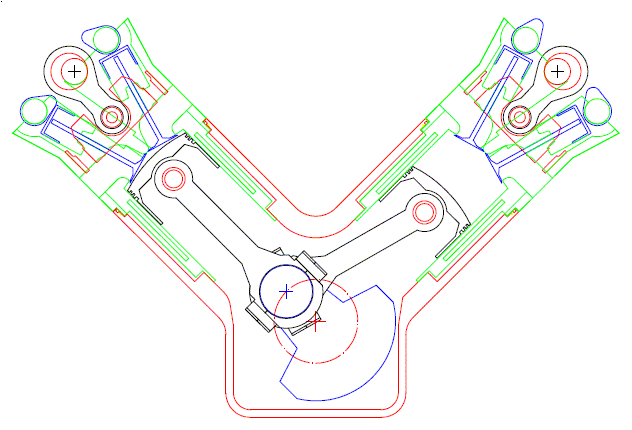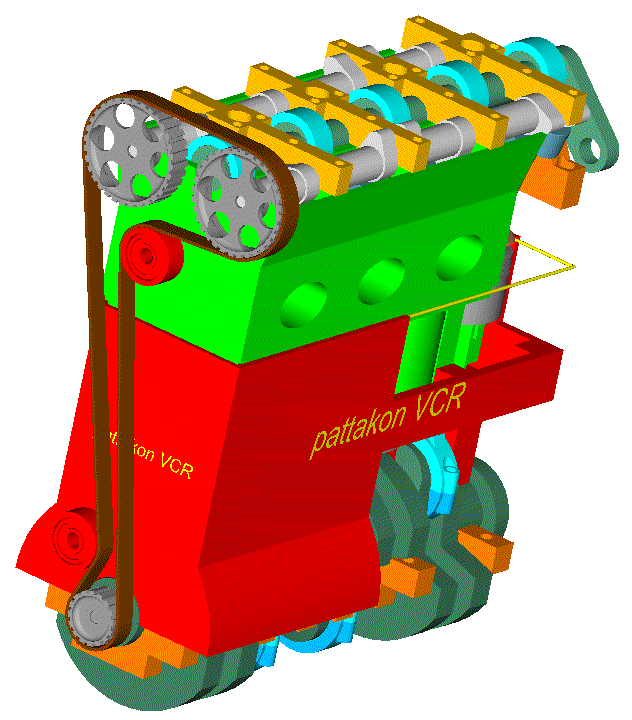Hello all
I wouldn't have thought that it would need explanation. Incredibly complex etc. - can you imagine this being able to operate at even moderately high RPM. The hinged-block layout (like Saab's VCR engine) seems far more practical.
Hello Kelpiecross.
The hinged-block like Saab's VCR engine, or the Sleeve-Block (sliding-block) like the PatHead VCR?

Here is the version for Vee engines:

More at http://www.pattakon....pattakonVCR.htm
Quote from http://www.pattakon....takonKeyAdv.htm
Multi-link VCR (Nissan's, Daimler's, Honda's etc) versus patcrank VCR
The multi-link VCR is based on a linkage between the crankpin, the big end of the connecting rod and the crankcase.
This linkage comprises a rocker pivoting about the crankpin, a rod and a control shaft.
The big end of the connecting rod is pivotally mounted at one end of the rocker, the rod is pivotally mounted at the other end of the rocker. The other end of the rod is pivotally mounted on the control shaft.
The displacement of the control shaft, relative to the crankcase, changes the compression ratio.
Because the rocker undergoes heavy bending loads, it is heavy and therefore its motion adds inertia loads and friction.
The piston force (due to gas pressure and inertia) loads the crankpin with some 1.5 times heavier force, because of the fulcrum action of the rocker. The rod is also loaded by about half of the piston force. All bearings undergo the respective forces adding friction.
The long chain of parts and bearings is under heavy inertia and combustion forces limiting the high revving capability and adding friction. Such a long chain of parts, being under such loads, adds torsional, twisting and flexing possibilities that call for double bearings, adding further mass, friction and reliability issues.
The inertia vibrations and the smoothness of the engine vary with the compression ratio. The displacement of the piston versus the crankshaft angle depends also on the compression ratio selected.
Because the control shaft handles a big part (about half) of the piston force, it needs to be adequately massive with strong supporting on the crankcase, away from the crankshaft axis, which calls for a heavier crankcase.
The inertia forces and torques resulting from the motion of the additional parts, reduce - in some arrangements - the external vibrations of the engine, yet these strong forces and torques load the crankshaft and the crankcase, limiting the high revving capability and increasing the friction. Similar case is the prerack_VCR_(animation_3.5MB) wherein a single cylinder VCR engine is, without balance shafts, perfectly balanced as regards its inertia forces, yet the inertia stresses limit its high revving capability.
The application in Vee engines (like the conventional V-8) is more trouble: per piston it needs a rocker and a rod, while a separate control shaft is necessary per bank of cylinders (for a V-8 it needs eight rockers, eight rods, two control shafts, i.e. 18 heavy, expensive and difficult to make and support parts).
. . .
MCE-5 VCR is based on rack-gears and on synchronized rollers for the thrust loads. To control the compression ratio, a control rack is displaced.
The block of the engine needs, per working cylinder, one additional control cylinder of similar size.
The quick moving parts are heavy and big in dimensions.
The inertia loads are heavy.
The rev limit is low.
The asymmetrical form of the piston adds inertia thrust loads on the cylinder wall.
The rollers need heavy preloading.
Because of the typical 20 degrees inclination of the teeth surface of the piston rack-gear, the one-sided piston rack-gear of the MCE-5 VCR adds an additional force (36% of the piston force due to gas pressure and inertia) that overloads the synchronized roller at any angle of the connecting rod.
NOTE: MCE-5 would start production in 2016. After US120million on R&D, they let it go (last news in their web site: 2013).
. . .
SAAB SVC versus pat-head VCR
To change the compression ratio, SAAB's SVC displaces (rocks) the cylinder head together with the cylinder block relative to the crankcase.
Its architecture (the cylinder head together with the cylinder block are pivotally mounted on the crankcase) generates heavy bending loads on the cylinder block and on the crankcase.
The kinematics and the inertia vibrations of the engine depend on the selected compression ratio.
It makes difficult the sealing (oil and noise) of the crankcase.
It makes difficult the connection of the exhaust system with the cylinder head.
It degrades the quality of operation of the engine by additional noise and vibrations.
The pat-head VCR resembles to SAAB's SVC in that it also displaces the cylinder head together with the cylinder block relative to the crankcase.
But the pat-head VCR displaces the cylinder head and the cylinder block linearly (i.e. parallel to themselves) and keeps untouched the kinematics and the balance of the engine, supports the forces in the proper way without creating heavy bending loads neither on the cylinder block nor on the crankcase, seals efficiently (oil and noise) the crankcase, allows conventional exhaust system conventionally secured on the cylinder head and maintains the operational quality (smoothness) of the engine.
In brief, the pat-head VCR is a continuously / infinitely Variable Compression Ratio mechanism that offers a compression-ratio range from less than 7:1 to more than 20:1.
It is mechanical.
It leaves untouched the kinematic mechanism of the engine and the smoothness of the engine and the high revving capability of the engine.
The crankshaft, the connecting rods, the piston pins and the pistons are conventional and they move exactly as in the conventional engine.
The mechanism receives the combustion loads and the inertia loads smartly, creating neither significant bending loads nor side effects.
It exploits the empty space into the conventional cylinder head.
The synchronization between crankshaft and camshafts is simple and accurate: A free roller (the red one, near the camshaft sprockets, shown in the VCR.wmv, 3.0MB, video-animation) has its center secured on the crankcase, i.e. its center remains immovable when the cylinder head moves up or down to change the compression ratio. This free roller changes the direction of the belt / chain, coming from the crankshaft sprocket, for about 90 degrees before it meshes with the first camshaft sprocket. Another free roller, beside the crankshaft sprocket, is the tensioner that takes the lash of the belt / chain (the conventional lash and the lash resulting from the approach of the camshafts to the crankshaft). This simple geometry keeps the timing between crankshaft and camshaft unchanged, no matter what the compression ratio is, i.e. the valves open and close at the same crankshaft degrees either at 20:1, or at 7:1 or at any other available compression ratio.
It can easily be adapted in multicylinder engines (like 2 or 3 or 4 or 5 or 6 cylinder in line, like 6 or 8 cylinder in Vee etc).
It fits even to small single cylinder engines, like those in motorcycles, electric generators etc.
The compression-ignition (Diesel) engines can also take advantage of the mechanism. 20:1 is a good compression-ratio for the "cranking" (even without glow plugs) and the warming of the engine, while 14:1 (or even lower) is a good compression-ratio for running the warmed engine.
In mass production the additional manufacturing cost is insignificant.
It is a simple, lightweight and compact, yet robust and fully functional VCR.
Compared to the state of the art, pattakon pat-head VCR is a complete solution that comes without significant side effects.
End of Quote
Manolis Pattakos














